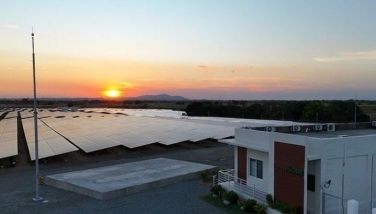A declared enemy of the state

There is no such thing as overpreparing for a possible disaster, especially for typhoons which are now more predictable than in the past. Whether it happens or not, as we always say, it is better to be safe than sorry. So it is not an exaggeration if we are prepared for the worst scenario even as we all hoped and prayed that such a potential super typhoon won’t pass.
“Ruby” started with the strength of a super typhoon when it was first spotted by our weather forecasters from the Philippine Atmospheric, Geophysical and Astronomical Services Administration (PAGASA) while it was still developing at the Pacific Ocean. Based from tracking last week of “Ruby” by PAGASA, it initially was packing maximum sustained winds of 195 kilometers per hour (kph) near the center and gustiness of up to 230 kph.
PAGASA forecasters warned us of storm surges that could reach up to five meters high in some areas, flash floods, landslides and winds strong enough to tear apart even the sturdiest of homes.
Up to now, the world’s strongest super typhoon ever recorded in recent history that wrought the most number of deaths and destruction occurred in the Philippines. Known by its international name “Haiyan,” a.k.a. “Yolanda,” the first-ever super typhoon struck us in November last year with deadly storm surges that nearly wiped out many cities and towns in Samar and Leyte.
Learning from the “Yolanda” experience, administration officials led by President Benigno “Noy” Aquino III adopted the policy that the Philippine government is never too prepared for any super typhoons from then on. The government, backed by the 120,000-strong military, launched massive preparations to attain a “zero-casualty” target. Realistically, “zero casualty” is easier said than done.
Armed with the PAGASA alert of a developing super typhoon and close tracking of its path or direction, all government agencies under the umbrella of the National Disaster Risk Reduction and Management Council (NDRRMC) began their respective preparations way ahead of Ruby’s projected entry into the Philippines. The PAGASA alert gave the NDRRMC at least three days head start to prepare for Ruby.
To its credit, PAGASA accurately predicted the behavior of Ruby as it moved toward Samar, Leyte and the rest of Eastern Visayas and Bicol region — which have always been the country’s typhoon belt area. People in these provinces still traumatized from “Yolanda” practically stormed heaven with prayers.
The NDRRMC, steered by its executive director, retired Philippine Navy flag-officer-in-command Alexander Pama, capably handled the government’s pre-disaster operations that could perhaps explain much less number of casualties from Ruby.
Pama effectively teamed up with the police, military and civilian authorities in the deployment of necessary forces and resources in key hazard areas earlier identified.
A retired military general himself, Pama rightly underscored that weather forecasting is not an exact science. But it is prudent, he stressed, to prepare for whatever contingencies. Whether people believe them or not, Pama said, they have to evacuate all those in harm’s way. “Bawal ang pasaway!” Pama told those who refused to evacuate.
Although initially categorized Ruby as a developing super typhoon, Mother Nature did the rest that eventually weakened it by the time it made landfalls to these provinces. Thankfully, there was no repeat of deadly tsunami-like storm surges.
When it made a fourth landfall in Batangas last Monday night, Ruby was downgraded to a tropical storm as it crossed the rest of southern Luzon. So when it finally arrived in Metro Manila on its way out of the Philippines, the rains and winds brought by Ruby were considerably weakened.
By historical average, our country experiences at least 20 typhoons every year. So it’s not far-fetched we may still have one or two more weather disturbances before the year ends. Ruby, with international name Hagupit — which means whip or lash in Filipino — was the 18th typhoon to visit the Philippines. Hagupit is the contribution of PAGASA to the international names of weather disturbances as adopted by the United Nations World Meteorological Organization.
Incidentally, many people ask why our country deviates from using international names for typhoons and instead adopts local names for them. This is because, as PAGASA explained, they treat every weather disturbance in the Philippine area of responsibility (PAR) as it starts to develop from tropical depression into tropical storm until it either dissipates or becomes a full blown typhoon.
In an interview over DzRH radio station, Armed Forces of the Philippines (AFP) chief of staff Gen. Gregorio Catapang Jr. declared “Ruby as an “enemy of the state” that the military would deal with all its might and resources. The AFP is among the front-line agencies of the government under the NDRRMC.
Army troops were deployed to supermarkets and major roads in provinces in the path of Ruby to prevent looters from taking advantage of any chaotic situation. The Army troopers were also deployed much earlier in these places in case there’ll be a need for clearing operations to remove debris, all of which slowed the government’s response during Yolanda.
The military and police were also tapped to ensure the massive evacuation of around 650,000 people living in low-lying and coastal areas and were transported to higher and safe grounds. A United Nations humanitarian agency spokesman, Denis McClean was quoted as saying in Geneva that it was one of the largest peacetime evacuations in Philippine history.
Weather scientists have warned that storms are becoming more violent and unpredictable because of climate change. That’s why many people readily leave high-risk communities.
The official count of casualty who died directly due to Ruby, and validated by the NDRRMC, stood at eight people as of press time. As per NDRRMC, Ruby also left 151 persons injured. More than 2.24 million people, or 492,710 families were affected. Of this total, 1.65 million individuals, or 369,193 families, have been displaced.
It is no exaggeration therefore that Ruby, and future typhoons from hereon, must indeed be declared as “enemy of the state” and must be dealt with the highest state of alert.
- Latest
- Trending

























